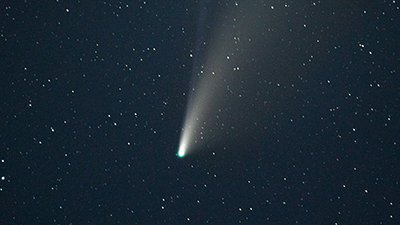Nemesis Comet Most Likely a Myth
News Source
Nemesis, the death-dealing star no one has ever seen, was invented to explain the “perceived periodicity of mass extinctions on Earth.” Nemesis is supposed to have regularly disturbed the Oort cloud—the purported birthplace of comets—causing the Oort cloud to periodically spew forth a hail of comets peppering the earth and killing things—lots of things.
The “death star” idea came about when secular geologists were trying to explain the fossil layers of the geologic column. Believing these massive burials to have occurred over long ages of time, they interpreted the fossil layers as mass extinctions and sought a cause. When the idea of a dinosaur-killing Yucatan asteroid impact became popular in the 1980s, scientists naturally looked to close encounters from outer space to explain other apparent extinction events.
Because statistics suggested a periodic increase in frequency of cratering, both on earth and the moon, Nemesis was born—at least in the minds of some. But a statistical analysis from the Max Planck Institute suggests the whole thing was much ado about nothing. Bayesian statistics—an analysis which attempts to predict future events based on previous occurrences—indicate there was never a periodic increase in impacts after all.
“There is a tendency for people to find patterns in nature that do not exist,” said study author Coryn Bailer-Jones. “Unfortunately, in certain situations traditional statistics plays to that particular weakness.”
But if this information puts your mind at ease, according to Bailer-Jones, it really shouldn’t. Instead of a periodic increase over the past 250 million years, he suspects “the impact rate, as judged by the number of craters of different ages, increases steadily.”
With complete confidence, Bailer-Jones says the impact rate is either increasing, or it isn’t. He explains that since it is easier to find newer craters than older ones, the increase may be an illusion. On the other hand, “There are analyses of impact craters on the Moon, where there are no natural geological processes leading to infilling and erosion of craters, that point towards just such a trend.”1 The jury is still out on that one.
So what are we to make of all this? Well, in the first place, the Nemesis-story was concocted to explain a series of assumptions which all began with rejection of the global Flood. This 19th century trend toward biblical compromise, chronicled by Dr. Terry Mortenson in The Great Turning Point, rejected the biblical idea of God’s catastrophic judgment and replaced it with uniformitarian thinking (2 Peter 3:3–6 warned Christians to expect this turn of events). Without a global Flood to explain the geologic column, the column had to be interpreted as a timeline of mass extinction events.
But the “death star” story drew from another fanciful idea, the notion of the Oort cloud. As secular scientists over the past couple of centuries kept pushing back the age of the universe farther and farther, they realized the universe had outgrown the lifespan of comets, which naturally melt away with time. Therefore the Oort cloud was invented as the mythical birthplace of comets at the outer reaches of our sun’s gravitational influence. The Oort cloud has never been observed.
The death star was simply a way of pulling the two stories together to make them explain a problem that we know from a biblical understanding of the world was never a problem anyway.
Further Reading
- The Search for a Cursed Cosmos
- Comets and the Age of the Solar System
- When Did Adam and Eve Rebel?
- Unlocking the Geologic Record
- Order in the Fossil Record
For More Information: Get Answers
Remember, if you see a news story that might merit some attention, let us know about it! (Note: if the story originates from the Associated Press, FOX News, MSNBC, the New York Times, or another major national media outlet, we will most likely have already heard about it.) And thanks to all of our readers who have submitted great news tips to us. If you didn’t catch all the latest News to Know, why not take a look to see what you’ve missed?
(Please note that links will take you directly to the source. Answers in Genesis is not responsible for content on the websites to which we refer. For more information, please see our Privacy Policy.)
Footnotes
- Max Planck Institute, “Does the Impact Rate For Asteroids Vary Periodically with Time?,” SpaceRef, August 1, 2011, http://www.spaceref.com/news/viewpr.html?pid=34239
Recommended Resources

Answers in Genesis is an apologetics ministry, dedicated to helping Christians defend their faith and proclaim the good news of Jesus Christ.
- Customer Service 800.778.3390
- © 2024 Answers in Genesis






